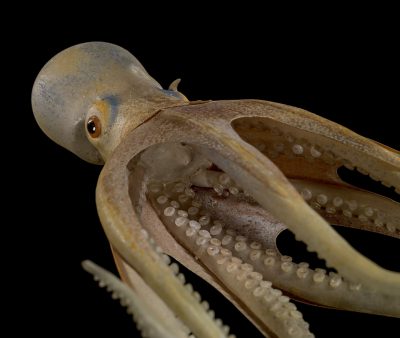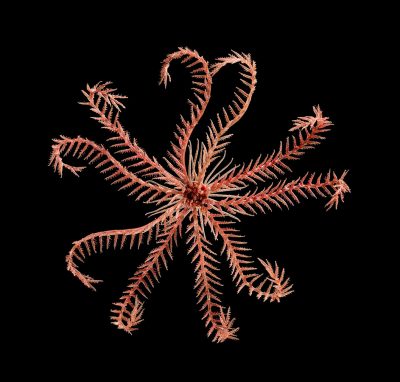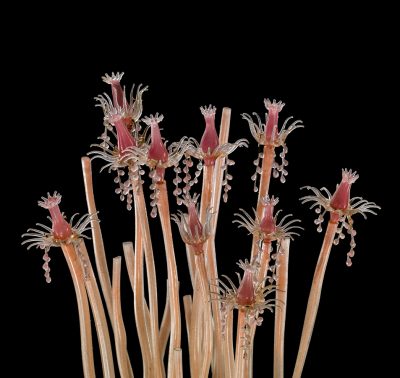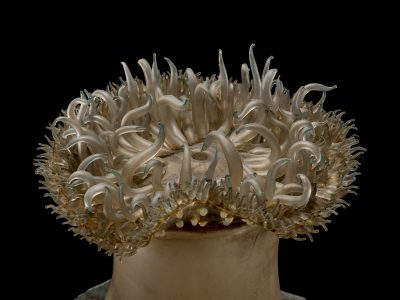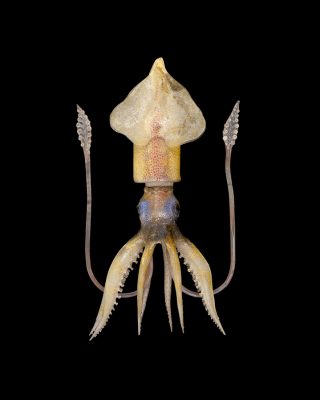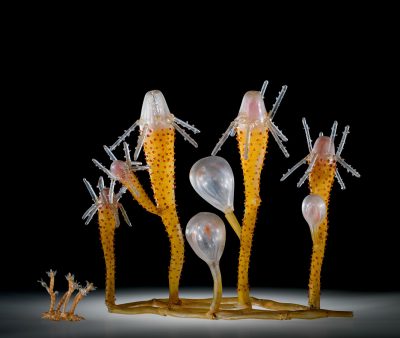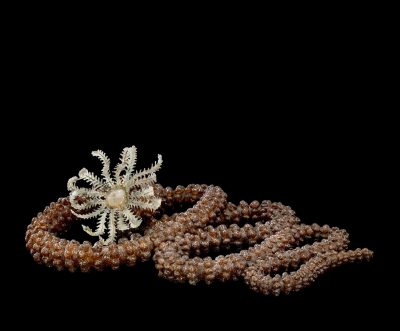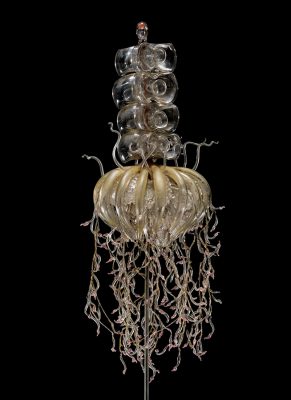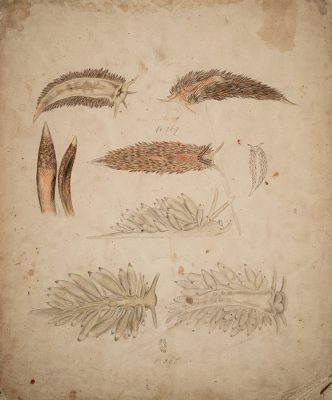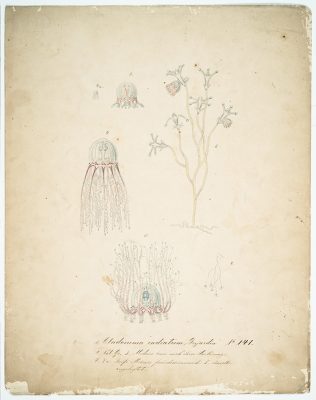
This May, The Corning Museum of Glass will present Fragile Legacy: The Marine Invertebrate Glass Models of Leopold and Rudolf Blaschka, an exhibition featuring nearly 70 exquisitely detailed glass models of marine invertebrates made by the legendary father-and-son team. Created as scientific teaching aids in the late 19th century, the models capture the diversity and splendor of aquatic life more than 100 years ago. On view at CMoG from May 14, 2016, through January 8, 2017, the exhibition will also feature nearly three dozen of the Blaschkas’ rarely displayed original drawings of sea creatures from the collection of the Museum’s Rakow Research Library, as well as a selection of flameworking instruments from their studio in Dresden, Germany. Alongside the historic material, videos and a digital interactive element will inspire visitors to explore the intersections of art and science, enter into the world of glass conservation, and posit important questions about marine conservation.
“As CMoG is the world’s premier institution for the study of glass, we’re proud to exhibit Leopold and Rudolf Blaschka’s stunning marine creations. Their innovative work has impacted art and science for generations, and still inspires artists and scientists today,” said Dr. Marvin Bolt, curator of science and technology and co-curator of Fragile Legacy . “In addition to illustrating the connections between the Blaschkas and marine biology research, the exhibition will look at the tools, techniques, and processes used to develop these unparalleled models.”
- Specimen of Blaschka Marine Life: Octopus Salutii (Nr. 573), Leopold and Rudolf Blaschka, Dresden, Germany, 1885. Lent by Cornell University, Department of Ecology and Evolutionary Biology. L.17.3.63-46.
- Specimen of Blaschka Marine Life: Comatula Mediterranea (Nr. 250), Leopold and Rudolf Blaschka, Dresden, Germany, 1885. Lent by Cornell University, Department of Ecology and Evolutionary Biology. L.17.3.63-10.
- Specimen of Blaschka Marine Life: Tubularia indivisa (Nr. 191a), Leopold and Rudolf Blaschka, Dresden, Germany, 1885. Lent by Cornell University, Department of Ecology and Evolutionary Biology. L.17.3.63-551.
- Specimen of Blaschka Marine Life: Bunodes crispa (Nr. 45), Leopold and Rudolf Blaschka, Dresden, Germany, 1885. Lent by Cornell University, Department of Ecology and Evolutionary Biology. L.17.3.63-71.
“The fragile, intricately–detailed, and colorful sea creatures on view—including anemones, octopi, sea stars, and even sea slugs—will illustrate the Blaschkas’ still-unmatched expertise with glass as a medium, while also transporting audiences to a hidden world beneath the sea more than 100 years ago,” added Alexandra Ruggiero, the exhibition’s co-curator. “The fragility of both the sea creatures and the glass models motivated our efforts to highlight stories of marine and glass conservation within the exhibition.”
Featuring gallery space designed by Annabelle Selldorf and Sara Lopergolo, exhibition designers and partners at Selldorf Architects, Fragile Legacy will include:
- A room of nearly four dozen glass invertebrate models, evoking the sense of an underwater scene
- A dozen models in specially built cases, lit to highlight their vivid colors and delicate forms
- Spectacular photographs of the Blaschkas’ fragile radiolarian models by contemporary artist Guido Mocafico: highlighting their stunning aesthetic and precise scientific features
Well known in the U.S. for creating the now-celebrated Ware Collection of glass flowers at Harvard University, the Blaschkas rendered their marine invertebrates with astonishing accuracy, using flame-working techniques that are still not fully understood. But the majority of their work was in the fabrication of the marine invertebrates, created with astonishing accuracy using flameworking techniques that are still not fully understood. Fragile Legacy will trace the evolution of their practice, and feature many of their original instruments and materials, including Rudolf’s workbench, bottles of powdered glass used to create a rich variety of colors, and matchboxes containing individual elements they prefabricated and later assembled. An early example of a marine invertebrate model, an anemone, contrasts with later, more sophisticated pieces, like the fluid Synapta maculate, a sea cucumber bursting forth with its mouth ringed in spiny tentacles, illustrating the considerable increase in their abilities to portray these species.
- Specimen of Blaschka Marine Life: Ommastrephes sagittatus (Nr. 578), Leopold and Rudolf Blaschka, Dresden, Germany, 1885. Lent by Cornell University, Department of Ecology and Evolutionary Biology. L.17.3.63-218.
- Specimen of Blaschka Marine Life: Perigonimus vestitus (Nr. 172), Leopold and Rudolf Blaschka, Dresden, Germany, 1885. Lent by Cornell University, Department of Ecology and Evolutionary Biology. L.17.3.63-293.
- Specimen of Blaschka Marine Life: Synapta glabra (Nr. 284), Leopold and Rudolf Blaschka, Dresden, Germany, 1885. Lent by Cornell University, Department of Ecology and Evolutionary Biology. L.17.3.63-20.
- Specimen of Blaschka Marine Life: Physophora magnifica (Nr. 213), Leopold and Rudolf Blaschka, Dresden, Germany, 1885. Lent by Cornell University, Department of Ecology and Evolutionary Biology. L.17.3.63-516.
Rarely exhibited drawings from the Leopold and Rudolf Blaschka Archive at CMoG’s Rakow Research Library are another highlight of Fragile Legacy. Characterized by a delicacy of line, these pencil, watercolor, colored pencil, and ink studies, complete with notes and marginalia by the Blaschkas themselves, served as preparatory sketches for the glass models. The drawings derived from a variety of sources, including published illustrations by naturalists, preserved invertebrates, and living creatures observed in their natural habitat or from within the Blaschkas’ in-studio aquarium. Several of the models in Fragile Legacy will be accompanied by their preparatory drawings, including the Cladonema radiatum (Blaschka Nr. 141), a small seajelly with jewel-like polyps on its tentacles, and the Aeolis papillosa (Blaschka Nr. 369), a sea slug whose shape and features account for its nickname, the “shag rug nudibranch.”
- Aeolis papillosa, Nr. 369; Aeolis exigua, Nr. 365. CMGL 95580.
- Cladonema radiatum, Nr. 141. CMGL 122327.
The Museum has accomplished glass conservators, Steven Koob and Astrid van Giffen, who have invested many hours researching Blaschka collections around the world and have painstakingly conserved most of the specimens on display in the exhibition. Recently conserved examples on display in Fragile Legacy include the Podocoryne carnea (Blaschka Nr. 173), an early life cycle of a seajelly. Found in four pieces, with a small section of the base missing, which had to be filled to stabilize the model.
CMoG and Cornell University
The majority of the models on view in Fragile Legacy come from the Cornell University Department of Ecology and Evolutionary Biology, which purchased 570 as teaching aids in 1885. With the advent of the aqualung and underwater photography by the mid-20th century, interest in the models waned, and Cornell’s Blaschka collection fell into disuse. It lay all but forgotten until the 1960s, when it was rediscovered and sent to CMoG as a managed loan for preservation and display.
CMoG’s longstanding relationship with Cornell is featured in a forthcoming documentary, also titled Fragile Legacy. Dr. Drew Harvell, a marine biologist in Cornell’s Department of Ecology and Evolutionary Biology and the curator of the Cornell collection of Blaschka glass, has joined underwater filmmaker David O. Brown on a quest to film living examples of the invertebrates that appear in Cornell’s collection of Blaschka models. The award-winning film will have its public premiere at the Museum in tandem with the exhibition opening. Excerpted clips will bring to life selected Blaschka models and drawings.
Fragile Legacy from David O. Brown on Vimeo.

